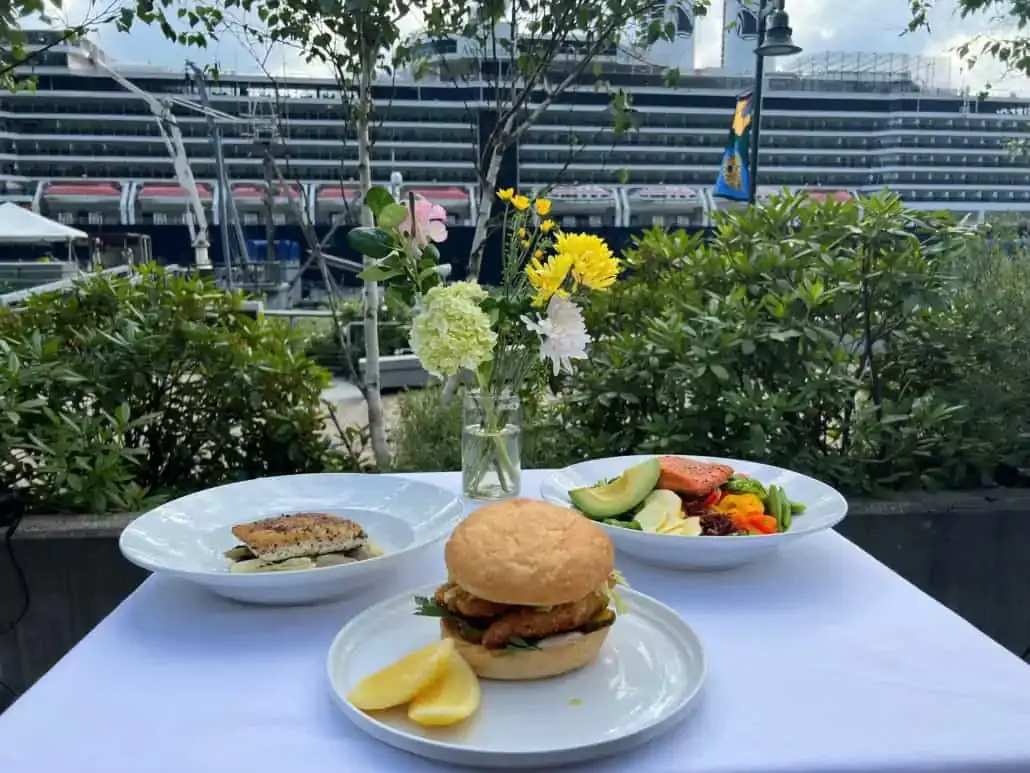Ships Serve Alaska Seafood by the Ton

While the major lines that visit Alaska have long partnered with communities, ports and other organizations on sustainable tourism initiatives, cruise has been increasing its purchasing and sourcing of local food, particularly sustainable Alaska seafood.
Holland America sailed six ships in Alaska last season – and purchased and served approximately 5,000 pounds of wild Alaska seafood per ship, per cruise.
That is more than 100,000 pounds in the 2024 season alone! As part of its commitment to sustainable sourcing, the cruise company is partnering with the Alaska Seafood Marketing Institute (ASMI) to help tell the stories of the people behind the fish, from the fishermen to the processors and the chefs. In the future, recipe development and in-destination video content will be featured.
Holland America pays close attention to ensuring the high quality of the Alaska seafood it serves on board and works with ASMI and the Alaska’s fishing industry to confirm the seafood’s origin through Responsible Fisheries Management, a third-party certification program for wild-capture fisheries. In addition, to date, 1,493 Holland America employees have taken the ASMI Alaska Seafood U course that teaches people “how Alaska’s long-term fisheries management practices ensure that this unmatched, delicious seafood resource can be enjoyed for generations to come.”
Cruise Lines and Alaska Seafood – a Natural Connection
EDITOR’S NOTE: This article first appeared in the Fall 2022 issue of National Fisherman.
By Renée Limoge Reeve
CLIA Alaska
Sustainability. It’s more than a buzz word for Alaska’s cruise and seafood industries. It’s a movement – a system that is interconnected with mutual respect so important to us it’s mandated by our state constitution. In Alaska, we brag about our sustainable, wild seafood, and the culture of respect that is uniquely Alaska.
These two industries are inextricably tied to our lives and livelihoods – past, present and future – demanding of themselves and others to operate responsibly. We do it as Alaskans and we expect others visiting our state to follow suit. Some might think it would be difficult to find another industry that could possibly match the level of commitment we have as Alaskans to protect our streams, rivers and oceans where our fish thrive. A surprising group is the cruise sector, one of the most misunderstood industries leading the way in environmental sustainability and embracing sustainable food sourcing – of which Alaska cruising is a model.
Despite the size of some cruise ships, cruise itself is actually a very small part of a larger maritime industry. Cruise ships comprise less than one percent of the global shipping fleet, yet we are at the forefront of research and development, driving innovations from which the entire maritime industry benefits with technologies that protect the environment and the waters on which we all depend.
Cruise Lines International Association (CLIA) is a global trade association representing more than 50 member cruise lines and 250 ships that comprise the vast majority of the world’s ocean-going passenger cruise capacity. We support policies and practices that foster a secure, healthy, and sustainable cruise ship environment. Our cruise lines meet and often exceed stringent national and international environmental laws and regulations and our clear commitment is to make net-zero carbon shipping a reality and to support a brighter, better and more responsible future.
From utilizing alternative fuels, shore power, and state of the art wastewater treatment systems, to LED lighting and the elimination of single-use plastics, the cruise industry is committed to leading the way toward clean air, clean oceans and environmental responsibility. Efforts go beyond what you might expect, to special paints for ship hulls that reduce friction as ships sail, to onboard recycling and biodigesters that reduce food waste.
Sustainability is at the heart of our culture at CLIA and drives what we do each and every day. Beyond our own operations, we seek partnerships with other industries and destinations who share our sustainability goals. For this reason, the marriage between cruise and Alaska seafood is a natural one. We know visitors are more focused than ever on where their food comes from, and Alaska seafood lets us tell a great story and serve a fantastic meal while our passengers enjoy the immense beauty of our state.
Alaska’s fishermen know that wild seafood is one of Alaska’s most precious resources and, with their help, our state goes to great lengths to ensure its continued abundance. Alaska seafood is responsibly managed using a world-leading, science-based approach, which is verified by third-party sustainable seafood certifications like Alaska’s Responsible Fisheries Management (RFM) program to help fish stocks, communities and entire ecosystems thrive for generations to come.
From fishermen and processors to scientists and law-enforcement officials, sustainability is not only crucial to Alaskans’ livelihoods and future, but it’s a deeply ingrained tradition that is important to the cruise industry.
Beyond the efforts of individual member lines that bring more than 40 ships to our market, CLIA is working with ASMI to find ways we can strengthen the relationship between the cruise and seafood industries in Alaska. We share the common goal of sustainability and we both work to promote this beautiful state we live in and the immense resources we’re blessed with. Both industries are significant to Alaska — providing jobs and sustaining local economies. The collaborative efforts of our industries expand the positive impacts of Alaska seafood and tourism to a broader range of stakeholders and Alaska seafood enhances visitor enjoyment and tourism businesses throughout the State. As they say, “a rising tide lifts all boats,” and in this case, those are fishing boats and cruise ships.
